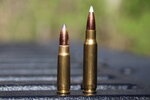The US Army people with stars on their personal flags ended WWII with something of a fixation on Known Distance shooting at extreme ranges (and on pristine range facilities).
And doctrinally, the US had a fifty year habit of shooting MG ammo in their rifles.
These were flip sides to functionally the same coin.
And, functionally, ignored all the actual aspects of actual battlefields. Where individual rifle-carrying soldiers tended to only engage targets they could see (and those targets were trying, typically, to Not Be Seen. And a good way to Not Be Seen was to not all stand up as a Squad and lob rounds off "thataway" a half kilometer or more off. Especially when you could just send somebody to the MG section/Squad and have them blast away from behind sandbags and the like. Where some other snuffies had drug up all the piles of ammo the MGers needed for such adventures.
Now, enough folk had come up through the muddy ranks to at least agree that modern warfare wanted smaller units, of greater agility, and often, in smaller group sizes than before. A significant way to accomplish that is by reducing ammo weight. Hacking 7.92x57 down to 33mm case length (59% as long) is one way. Doing similar to 7.62x54r to 7.62x39 (72% as long) is another.
Now, when the US Army boffins looked at going from 7.62c63 to 7.62x51 (81% case length) they were convinced they were "still in the ballpark."
They wanted it to be an 800-900meter ballpark and not 1200m.
And they wanted it to be MG ammo, too. That despite decades and score of years of separation of those ammo supplies at Brigade and Regiment levels.
It took until Curt LeMay wanted AF security troopies to have "more rifle" than their aging 30 Carbines, and entertained giving them all GAU-5s bought of fan AF contractor, Fairchild to really stir the pot and cement the notion of a "rifle cartridge" and an "MG cartridge" (which was then muddied when FN ginned up the Minimi as a rifle-cartridge Squad Auto Weapon, later adopted as the M-249).
So, to OP's point, there's likely no biological difference, just an engineering difference. Shoot a goat with a 9x17, another with a 9x18, and a third with 9x19--the goats are unlikely to be that different in end result We, in the "gun culture" are easily "hung up" on engineering differences. That's because "we" tend to be a precise lot, and pay attention to small, but significant details.
We also tend to apply logic and reason to things around "us," as well. This get complicated when applied to nights like militaries, governments, and the like, where being "thick as a plank" is so common as to appear to be a prerequisite. Applying logic where none exists is fraught with difficulties.
Sorry, but there is a lot wrong here.
First, the Army did not have a fixation on KDR, the post-war Army was the one that initiated the research what would evolve into TRAINFIRE. This research was done with multiple parallel tracks, "What is the most likely range a combat engagement will take place?" "What is the best way to train people to shoot accurately?" "What shooting positions are most relevant to combat shooting?" "What would be the best target?" "How should progress be measured?" etc. After a lot of research and development, the best affordable, and usable, system was fielded. How good it actually was/is is another debate, but also beside the point, which is the Army looking to make marksmanship training as realistic as possible from very early on.
Second, the 7.9 Kurtz was never intended to less powerful rifle, but a more powerful submachine gun. German infantry doctrine was that the assault element would hold fire until with 100 meters of the objective, then, and only then, they would rush the objective, firing at the maximum rate possible. Troops found SMGs best in this application. During the movement to the objective
all fire was by indirect weapons or the next higher element's MGs. This is very different from US infantry doctrine. Soviet doctrine was different still.
Third, the US were not fixated on long range fire, but AP performance, as noted above. This is the reason why the US turned down the British 7mm. The early T65 cartridge was loaded with a 130 grain projectile, similar to the British round, but at a much higher velocity for a flatter trajectory (which makes range estimation less an issue). Eventually, effectiveness against vehicles drove the projectile weigh up.
Fourth,
Shoot a goat with a 9x17, another with a 9x18, and a third with 9x19--the goats are unlikely to be that different in end result
If by "end result" you mean - there is a hole in the animal - you are correct. If by any other assessment, there is a good bit of difference, how long it lives after been holed (if it actual was killed by the shot), its initial reaction to being shot, amount and type of tissue damage, etc. This was well demonstrated during the "Homologous series of Rifle" tests, which tested similar construction .22, .25, .27 and .30 caliber rounds against goats and ballistic gelatin.
Fifth, Lemay wanted the AR-15 to replace the Carbines with the Air Police. The GAU-5A/A (aka XM177) was not examined by the military until 1965 with the CAR-15 Submachine Gun



